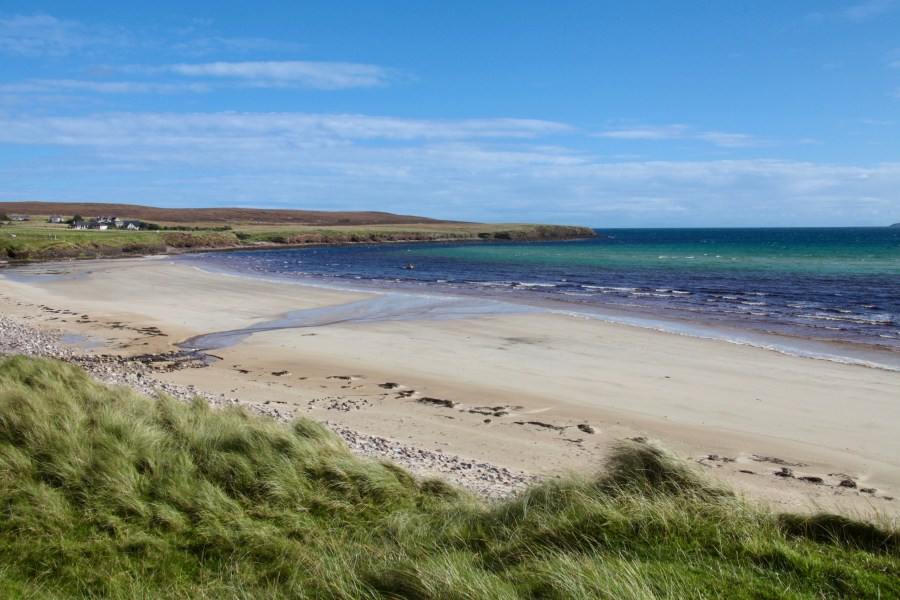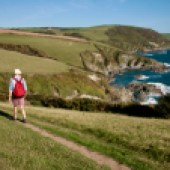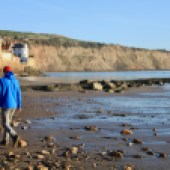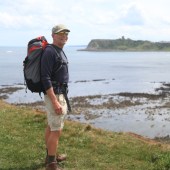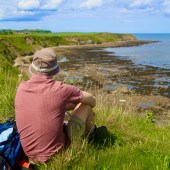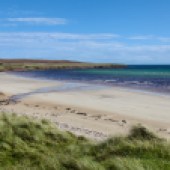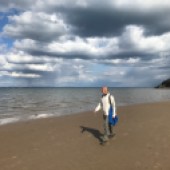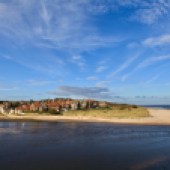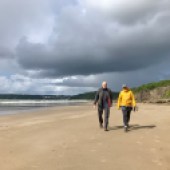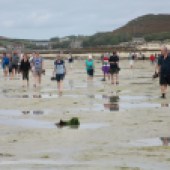Never mind the threat of challenging weather… this time of year is ideal to get out and enjoy our coastline on foot, as Paul Miles shares as he takes us on a coastal walk.
Someone was hurling carpet tacks at me. At least that’s what it sounded like through my coat’s hood. The path had become a stream and my boots squelched with every step. No wonder no-one else was out walking. Yet the wildness of it all – wind so strong it was difficult to stand – made me yelp with excitement.
Walking is good for us. The physical benefits are numerous: weight loss, lower blood pressure, increased heart and lung fitness. The mental health benefits too: reduced stress, improved mood, better sleep. But can we really enjoy a coastal walk in winter?
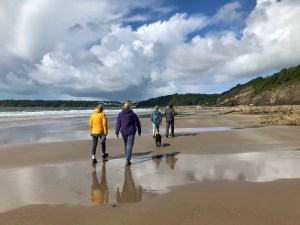
Walking with friends on the beach near Amroth, Pembrokeshire
On that November day of lashing rain and howling wind, the main joy was returning to base, pouring water from my boots, peeling off sodden clothes and having a hot shower. Some might argue it would be easier to shortcut directly to hot shower? But there’d be no immersion in wildness, no calories burnt or thoughts settled.
Winter walking isn’t the sole preserve of masochists. Anyway, ‘there’s no such thing as bad weather, only inadequate clothing’ say the Norwegians. (I must need a new coat). Even in the depths of winter, there are rare and precious days of fine weather: crisp blue days when the pleasure of being outside, enjoying the sun’s warmth, is undeniable. So winter is not the time to put away your hiking boots but rather to have them ready at a moment’s notice.
Walking by the coast is, in my opinion, the most enjoyable. At its simplest – a linear route, with no river mouths or other obstacles around which to detour – you rarely need a map. Just keep the sea to one side and you can’t go wrong. If walking is not physically possible then the seaside has miles of wheelchair-friendly promenades and accessible paths.
A coastal walk is a treat for the senses. Pebbles crunch and squeak underfoot, waves roar. There’s the coconut smell of gorse and the tang of briny air. Visually, even if it’s so foggy that visibility is reduced to a few feet, there are details to observe: a colourful sea shell, the curvy way pattern of a drystone wall.
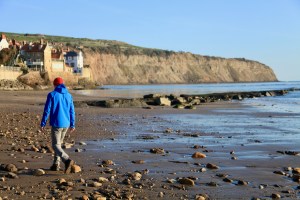
Robin Hood’s Bay, Yorkshire, on the route of the Cleveland Way
When the mist lifts it reveals dramatic seascapes: pools of distant silver as sun beams burst through clouds or a dazzle of glitter under a cloudless sky. The sea’s surface windswept with white horses or barely rippled with a cat’s paw. The ebb and flow of the tide is the major scene-stealer though as the ocean is pulled by the moon, the landmass growing and shrinking, the planet breathing: in, out, in, out.
Scottish poet Kathleen Jamie writes in ‘Poem’ about a “walk at the land’s edge”. The land’s edge and the intertidal zone – neither fully land nor sea, a liminal space – holds a fascination. It is a place of change, of mystery, of revelations.
Poets, philosophers, authors and composers also find inspiration on foot. Walking – alone with a notebook and a keen sense of observation – can be thinking time, a slow moving meditation. Beethoven took daily afternoon walks “under trees and over rocks”. He wrote in his journal: “Nature is a glorious school for the heart!” The philosopher Jean Jacques Rousseau wrote that he could “only meditate when I am walking. When I stop, I cease to think; my mind works only with my legs.”
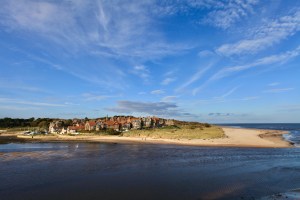
Big wide beaches for walking in Alnmouth, Northumberland
Coastal walking has its origins in more down-to-earth professions though. Early coast paths were trodden by smugglers, coastguards, fishermen, farmers and bearers of coffins. Only pilgrims walked for a ‘higher’ purpose, not of this world. Walking for leisure comes closest to this.
Today, rather than collecting holy souvenirs to record spiritual progress, keen walkers keep log-books and highlight completed paths on maps or count steps on Fitbit or phone. The focus is physical exertion, keeping fit, exercising the dog or a sense of achievement. It is the challenge of a long-distance path and, unlike the philosopher or poet, an attention to speed, or at least measurement.
The exact length of our coastline is difficult to measure. How many teeny bays and headlands do you include? At what state of the tide? No wonder statistics vary but the OS estimates the coastline of Great Britain is 17,819km. Add the islands and that increases to 31,368km.
The coastal paths don’t follow the very edge of the land, of course. The England Coast Path, an evolving project which Natural England begun in 2012, will be 4,500km long when complete. The Wales Coast Path, completed in 2012, is 1,400km long. Scotland is considering something similar, joining up its various coast paths.
Sometimes, at very low tides, individual islands become one. Holidaymakers revel in the appearance of otherwise submarine pathways. In the Isles of Scilly, I’ve accompanied crowds to walk between Bryher and Tresco, like the Israelites crossing the Red Sea. Food and drinks stalls were set up on the wet sands for the hours that Neptune allowed.
Sociable walking with friends or family – or welcoming strangers – lifts our mood too. It is time to talk and share. Sometimes it’s easier to say things straight ahead, into the salty air, as you walk side by side.

Watching the sun set at the end of a day’s walking, Oban, Scotland
For three decades now I’ve holidayed in a Pembrokeshire seaside village with the same friends. Each year we walk the same stretches of coastline, sometimes on the cliffs or, if the tide allows, along the beach.
We’ve carried babes that are now adults. We’ve mourned the loss of loved ones. Despite changes in our lives, there is a constancy about those cliffs and beaches that reassures. A constancy, yet an ever-changing nature too, with tides and erosion and sea-levels rising. The coast is the bellwether of climate change. In decades to come our coastline will be shorter, our landmass smaller. It’s a sobering thought.
We can all do our bit. Using public transport instead of driving is one small example. From this month [January] until March, single adult fares on most bus services in England outside London are capped at £2. There are superb coastal bus routes in England. Catch the bus and do an easy linear coast walk back to base. Happy hiking!
If you’re thinking about going on your own coastal walk, discover our top 5 favourite coastal walks, and reap the benefits by finding out why coastal walks can make you happier here.

